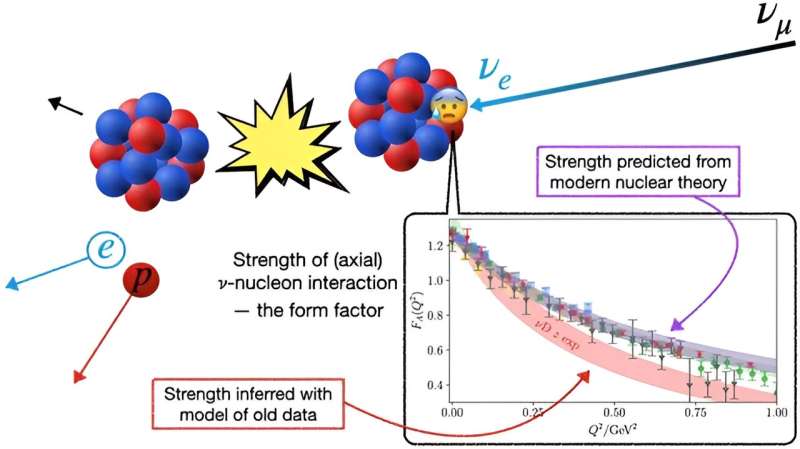This article has been reviewed according to Science X's editorial process and policies. Editors have highlighted the following attributes while ensuring the content's credibility:
fact-checked
trusted source
proofread
In preparation for DUNE, scientists examine modern nuclear theory for neutrino oscillation physics

The U.S. particle physics community is preparing for a major research program with the Deep Underground Neutrino Experiment (DUNE). DUNE will study neutrino oscillations. These quantum mechanical oscillations are only possible because neutrinos have mass, albeit it very small masses.
Research at DUNE will address key questions about neutrinos, such as whether they and their antineutrino counterparts behave differently. Answering these questions could help explain why the universe is composed of matter and not antimatter.
These studies require a detailed understanding of how neutrinos interact with atomic nuclei and the nucleons (protons and neutrons) that make up nuclei.
By providing new data, DUNE will help scientists advance beyond the current understanding of neutrino-nucleon interactions, which relies upon data from experiments in the 1970s and '80s.
Scientists use the nuclear theory method called lattice quantum chromodynamics (LQCD) to predict neutrino-nucleon interactions. The LQCD results predict a stronger neutrino-nucleon interaction than predictions determined from older, less precise, experimental data. The work was published in the Annual Review of Nuclear and Particle Science.
This research demonstrated important implications of how scientists interpret neutrino oscillation signals from LQCD. It also identified the next results to tackle with LQCD. These findings, combined with modern many-body nuclear theory methods, will reduce the potential biases due to incorrect modeling. The findings will also improve scientists' predictions of these interactions for DUNE and other neutrino experiments.
A recent project by researchers at the University of California, Berkeley and Lawrence Berkeley National Laboratory demonstrated the importance of incorporating state-of-the-art theoretical predictions of the "nucleon axial form factor" into simulations of neutrino-nucleus reactions (a form factor is a measure of the "squishiness" of a particle—the smaller the value, the squishier).
Scientists need these form factors to determine oscillation properties of the elusive neutrinos that will be explored by DUNE and other leading neutrino oscillation experiments. The most advanced LQCD predictions conflict with the older phenomenological models of the axial form-factor, leading to a 30% larger neutrino-nucleon cross-section. This has important implications for the interpretation of the oscillation experiments. These LQCD calculations are made possible by the Department of Energy's Leadership Class Computing Facilities, which house the fastest supercomputers in the world.
In the exascale computing era, scientists will further refine the LQCD results and tackle additional, more complicated processes. The results will be combined with modern many-body nuclear theory methods to provide more robust predictions of the neutrino-nucleus reactions. These predictions are essential ingredients for interpreting the next-generation neutrino oscillation experiments, such as DUNE, and inferring properties of neutrinos.
More information: Aaron S. Meyer et al, Status of Lattice QCD Determination of Nucleon Form Factors and Their Relevance for the Few-GeV Neutrino Program, Annual Review of Nuclear and Particle Science (2022). DOI: 10.1146/annurev-nucl-010622-120608
Provided by US Department of Energy





















